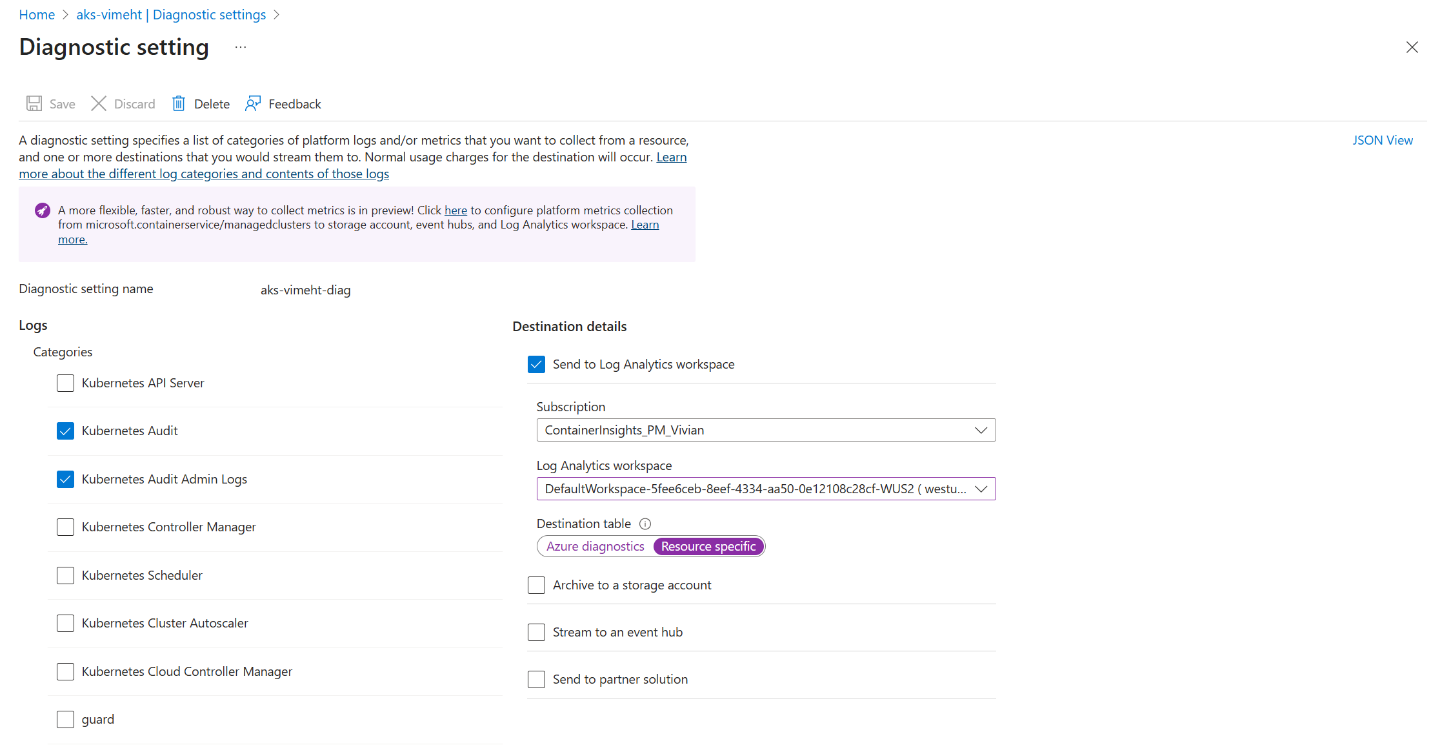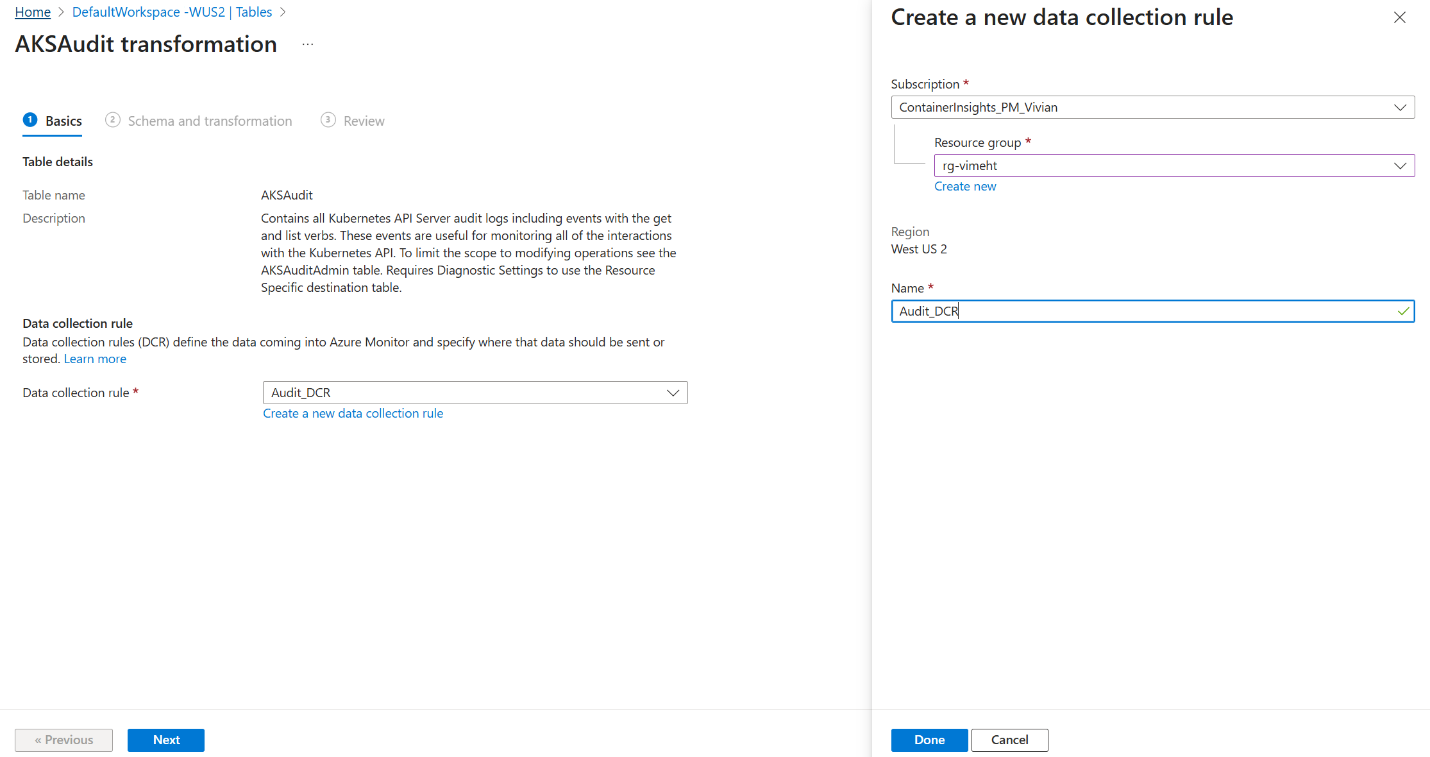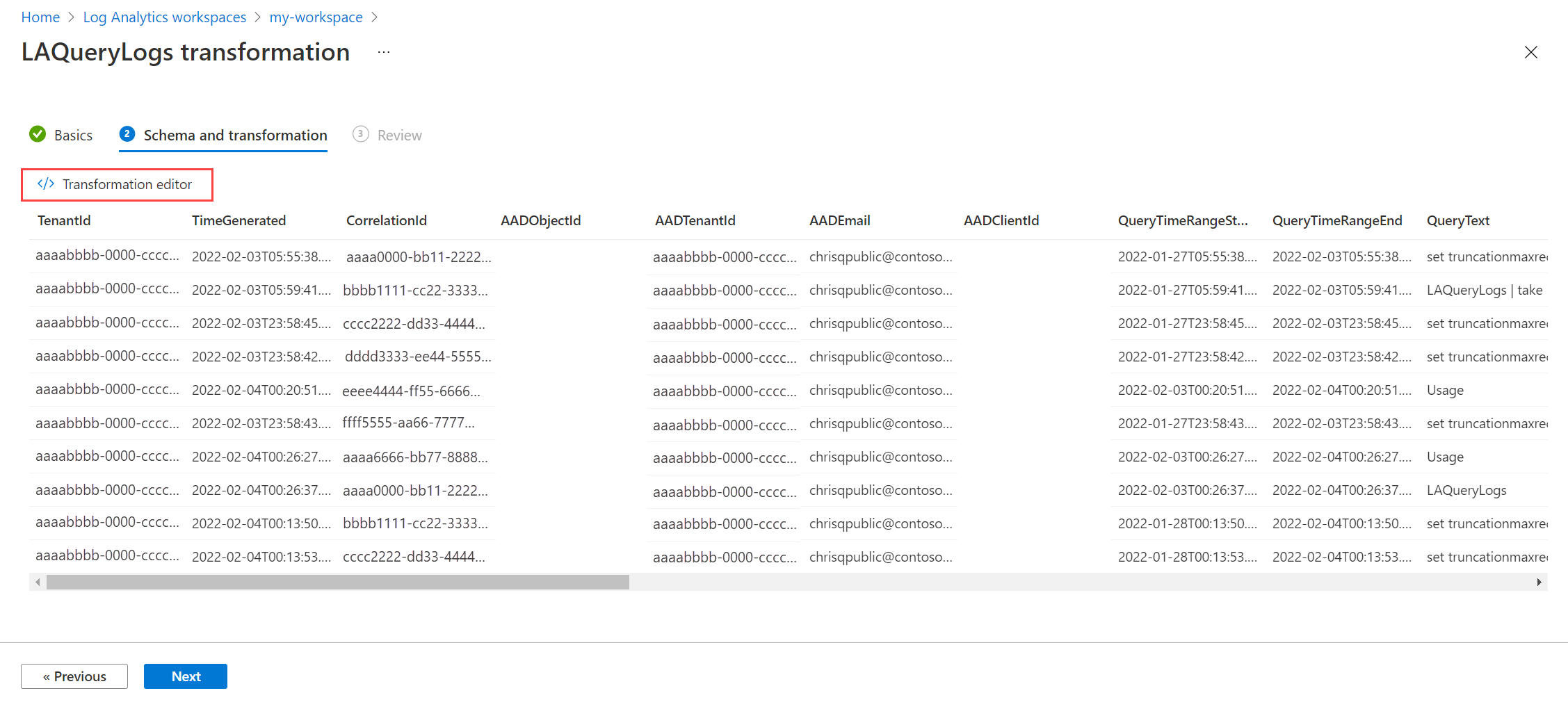Note
Access to this page requires authorization. You can try signing in or changing directories.
Access to this page requires authorization. You can try changing directories.
This tutorial walks through configuration of a sample transformation in a workspace data collection rule (DCR) using the Azure portal. Transformations in Azure Monitor allow you to filter or modify incoming data before it's sent to its destination. Workspace transformations provide support for ingestion-time transformations for workflows that don't yet use DCRs.
Workspace Transformation DCR
A workspace transformation DCR is a special DCR attached to your workspace. It allows you to apply ingestion‑time KQL transforms to supported tables even when data is sent from diagnostic settings or other non‑DCR flows. You can define multiple transformation rules—one per table—in the same DCR. Learn More.
Note
This tutorial uses the Azure portal to configure a workspace transformation. For the same tutorial using Azure Resource Manager templates and REST API, see Tutorial: Add transformation in workspace data collection rule to Azure Monitor using resource manager templates.
In this tutorial, you learn how to:
- Create ingestion‑time transformation rules for AKS control plane tables.
- Filter out noisy or low‑value control‑plane events (e.g., ListPods, GetConfigMap).
- Validate filtering and monitor ingestion volumes.
Prerequisites
To complete this tutorial, you need:
- A Log Analytics workspace where you have at least contributor rights.
- Permissions to create DCR objects in the workspace.
- Diagnostic settings sending
AKSAudit,AKSAuditAdmin, and/orAKSControlPlanelogs to the workspace. - Some existing control‑plane log entries in those tables.
- No existing Workspace DCR linked yet (if applying transformations via portal first time)
Overview
Azure Kubernetes Service (AKS) emits several types of control plane logs that help you monitor, audit, and troubleshoot cluster activity. These logs—such as AKSAudit, AKSAuditAdmin, and
AKSControlPlane capture a wide range of events including user operations, system activity, and high-privilege administrative actions.
While these logs are valuable for security and compliance, they can quickly become high-volume and expensive to store, especially in clusters with frequent read operations or automated scripts. Many of these events (ListPods, GetConfigMap for example) are rarely used in queries, dashboards, or alerts and can safely be filtered out to reduce ingestion costs.
Ingestion-time transformations allow you to selectively filter or shape incoming log data before it’s stored in your Log Analytics workspace. This helps you reduce noise, optimize storage costs, and retain only the events that are meaningful to your team.
Enable Control Plane Logs for Ingestion
Before applying ingestion-time transformations, ensure that you have a diagnostic setting instructing your AKS cluster to send the relevant control plane logs to your Log Analytics workspace. This setup allows the transformation engine to receive and process data from tables like AKSAudit, AKSAuditAdmin, and AKSControlPlane.
This step is only required if you're not already collecting these logs. If your workspace is already receiving AKS control plane logs, you can skip to the next section.
In the Azure portal, go to your AKS cluster.
Under Monitoring, select Diagnostic settings.
Click + Add diagnostic setting.
Enter a name for the diagnostic setting, such as
AKSControlPlaneLogs.Under Destination details, select:
- Send to Log Analytics workspace
- Choose the same workspace where you’ll configure the transformation
Under Log categories, check the boxes for:
- KubernetesAudit
- KubernetesAuditAdmin
- KubernetesControlPlane
Click Save.
Add a transformation to the table
In the Azure portal, go to your Log Analytics workspace, and select Tables in the left-hand menu.
Find
AKSAuditin the list and click Create transformation.If this is your first workspace transformation, you'll be prompted to create a new workspace transformation DCR. Give it a name, then click Done and Next.
Select Next to view sample data from the table. As you define the transformation, the result will be applied to the sample data. This allows you to evaluate the results before you apply it to actual data. Select Transformation editor to define the transformation.
In the transformation editor:
source | where OperationName !in~ ("ListPods", "GetConfigMap", "GetDeployment")sourcerepresents the incoming log data.- The
wherestatement drops common low-value operations and retains other events.
You can modify this KQL to filter by other fields such as
ResourceGroupName,Identity,StatusCode.Run the preview to validate that rows are dropped as expected.
Select Apply to save the transformation and then select Next to review the configuration. Select Create to update the DCR with the new transformation.
Validate the transform
Wait 30 minutes for rules to take effect.
In Logs, run comparisons before and after:
AKSAudit | summarize count() by OperationName AKSAuditAdmin \| summarize count() by OperationName AKSControlPlane \| summarize count() by EventTypeVerify volume drops and that key operations still appear.
Potential costs
Azure Monitor charges for data ingested into the workspace and for processing transformations. If your rule drops >50% of incoming data, a processing charge may apply. If Microsoft Sentinel is enabled on the workspace though, transformation processing charges are waived.
Troubleshooting
Transformation syntax errors: will be shown in the wizard preview before applying.
Missing new columns in IntelliSense: may take up to 24 hours to update after transformation adds schema changes.
Dynamic column issues: use
parse_json()before operations on dynamic fields.Monitor workspace health and ingestion metrics to ensure volumes drop as expected.


